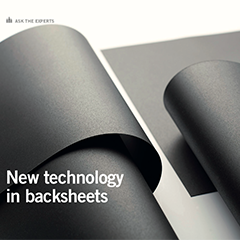PES caught up with the joint managing directors of Isovoltaic Solinex, DI Thomas Rossegger and Mag. Matthias Meinl. They lead a very experienced team in backsheet technology and have customers all over the globe. Their latest offering is polypropylene-based and out performs similar products on the market. R&D and innovation remains a constant quest.
PES: Welcome to PES Solar/PV magazine, it’s great to talk with you. Could you begin by explaining a little about the background of ISOVOLTAIC SOLINEX and the importance of the solar/PV industry to you?
Thomas Rossegger & Matthias Meinl: At Solinex, we have accumulated more than 30 years in the backsheet business within the global PV industry. Being a carve-out of long-standing Isovoltaic AG, our team has extensive experience and an excellent network on the market. As such, we combine the benefits of a new and innovative company, offering a highly reputable product, to the global PV industry with an outstanding, qualified and experienced team.
At Solinex, we are continuing the innovative spirit that our original company Isovoltaic, has always been known for and du to this we are leaders in the global backsheet market. Our dedicated mission is to cater to the global PV industry, with a product portfolio that offers our clients a highly attractive combination of competitive advantages, in terms of product performance, cost of ownership and ecological considerations.
PES: Is this still a growing market for you?
TR & MM: In the long run, we believe that the global PV industry will continue to grow significantly as renewable energy production becomes more and more important to the world. As such, we continue to be committed to the industry: a trusted business partner, known for innovation and quality. This being said, it is evident that the immaturity of the industry still features high amplitude volatility and massive transformation.
The recent move of the Chinese government to reduce domestic installation is just the latest in a sequence of events that have rattled the market in the past years and we believe that it will not be the last. We consider these a natural evolution process that will certainly challenge all market participants alike.
Nonetheless, with the right setup, product portfolio and a continuously innovative mindset, we are convinced that we are in a position to continue supporting the further development of the global PV market to a mature and self-sustaining industry.
PES: We have been hearing about your ICOSOLAR® CPO 3G backsheet, can you explain what it is and its benefit to the customer and end user?
TR & MM: ICOSOLAR® CPO 3G is the most recent result of our continuous quest for innovation. With ICOSOLAR® CPO 3G, Solinex was the first company globally to introduce a full polypropylene-based backsheet to the market. It was designed as a mono-layer and co-extruded in a single production step so as to combine the benefits of area-specific functionality in the backsheet, with full protection against delamination. In terms of technical functionality, the product range outperforms conventional backsheet compositions in a multitude of aspects such as reflectivity, damp heat performance, UV resistance, acetic acid permeability and mechanical features.
In addition, the performance of ICOSOLAR® CPO 3G economically benefits both module producers through its simple processing and investors through equipping modules with an extended lifetime at increased output.
Thus, ICOSOLAR® CPO 3G combines both technical and economic advantages against conventional backsheet compositions. Eventually, its polypropylene basis allows for full recyclability, thus adding to the technical and economic benefits and contributing to the PV industry’s ambition to deliver truly clean energy.
PES: Please could you explain what hydrolytic stability is and how it affects PV module backsheets?
TR & MM: Hydrolysis is the cleavage of chemical bonds in polymers by reaction with water. This reaction occurs mainly in polymers that take up a lot of moisture and that have water-sensitive groups in the polymer backbone. PV-modules in the field and consequently, PV-module-backsheets are in constant contact with humidity. This is why backsheets need to be highly resistant to hydrolysis in order to avoid polymer degradation.



























